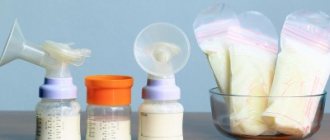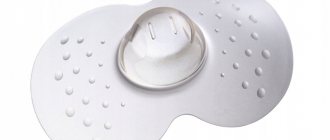This topic will discuss the correct use of a manual breast pump.
Every mother and expectant mother needs to know all the nuances associated with giving birth and raising a baby. No one argues with the fact that the birth of a child is a great and long-awaited happiness. But you need to clearly understand that motherhood sometimes entails certain difficulties, such as expressing breast milk.
But technology has stepped forward and now special devices can be used for these purposes. Therefore, today we want to share with you information on how to properly use a manual breast pump.
Difficulties with breastfeeding may occur if
- you need to go to work, study or run errands;
- the child is premature or has diseases that prevent sucking;
- the breast is hard and full - it is difficult for the baby to suck;
- it hurts to feed because of cracked nipples;
- the mammary gland is inflamed (mastitis);
- you have been temporarily prescribed the necessary medications; they are contraindicated while breastfeeding;
In all these cases, pumping helps maintain or establish breastfeeding.
How often should I pump?
To maintain or increase lactation, express regularly. The more often you empty your breasts, the more milk you will produce. It is formed “on request”. This is regulated by 2 hormones: prolactin and oxytocin.
The first one “releases the plan” to the mammary gland for milk, depending on how much was needed last time. Oxytocin allows stored milk to flow from the breast in response to nipple traction - this is called the oxytocin reflex.
How to signal to your body how much nutrition you need to create for your child?
If you don't have enough milk, pump every hour for the first few days. Then you need to express as often as the baby would like to eat: usually every 2-3 hours. This regimen is also suitable for maintaining lactation. At night you can take a break for 4-6 hours.
How long can I use expressed milk? Look at the table. It refers to milk collected in a sterile container. Write the date of collection on the container.
Part 2: How to Use a Manual Breast Pump
Using a manual breast pump is very easy. Regardless of the type of manual breast pump you have, the rules for expressing are almost the same.
- Place the breast pump funnel on your breast
- Make sure that the nipple is exactly in the center of the breast shield. Incorrect placement can lead to chafing and cracks.
- Begin to press the handle/pump rhythmically and gently. You can make a few quick, gentle movements, imitating the baby's sucking movements before the flush occurs.
- When you feel the rush, press down on the handle at a pace similar to your baby's eating pace. It's usually sip-pause-sip. At first, small drops of milk will flow into the breast pump, which will later be replaced by streams.
- Continue expressing milk at this pace as long as it is effective.
- When the milk stops dripping from the breast, you can switch breasts or try to induce another let-down, again using more frequent and less forceful strokes.
- When you're done pumping, be sure to wash all parts of your breast pump, dry them, and put them back together.
- Depending on how long you plan to store your expressed milk , store it in a cool place, such as the refrigerator or freezer.
How to use a manual breast pump: video
[Back to the beginning of the article]
How long can expressed breast milk be stored and how to store it correctly
— at room temperature for 4 hours; — in the refrigerator at a temperature of 4 ± 2°C for no more than 24 hours; — in the freezer at -18°C for 3–12 months. (optimally no more than 3 months).
Tiunova Elena
K.M.N., pediatrician of the highest category, nutritionist
“Pour out the breast milk after pumping if you were prescribed medications during breastfeeding that are contraindicated for breastfeeding.”
If you need to make your breasts softer for comfortable feeding, then you decide how much to express. How to start the process?
Expressing breast milk
Eglash, A. ABM clinical protocol #8: Human milk storage information for home use for full-term infants (original protocol March 2004; revision #1 March 2010). Breastfeed Med 5, 127–130 (2010). — Eglash A., Simon L., “ABM Clinical Protocol No. 8: Home Storage of Milk Intended for Term Infants,” (original protocol March 2004, first revised March 2010) Brestfeed Med (Breast Medicine feeding) 5, 127-130 (2010)
Eteng, M.U., Ebong, P.E., Eyong, E.U. et al. Storage beyond three hours at ambient temperature alters the biochemical and nutritional qualities of breastmilk. Afr J Reprod Health 2001;5:130–134. — Eteng M.U., Ebong P.I., Eyong I.U. et al., “Storage at room temperature for more than three hours affects the biochemical and nutritional properties of breast milk.” Afr J Reprod Health 2001;5:130–134.
Hill, PD, Aldag, JC, Chatterton, RT Initiation and frequency of pumping and milk production in mothers of non-nursing preterm infants. J Hum Lact. 2001;17(1):9–13 — Hill PD, Aldag JS. and Chatterton, R.T., “Onset and frequency of expression and milk production in mothers of non-breastfeeding preterm infants.” J Hum Lact (Journal of the International Association of Lactation Consultants) 2001;17(1):9–13.
Hill, PD, Aldag, JC, Chatterton, RT, Zinaman, M. Comparison of Milk Output Between Mothers of Preterm and Term Infants: The First 6 Weeks After Birth. J Hum Lact. 2005 February 1, 2005; 21(1):22–30. — Hill P.D., Aldag J.S., Chatterton R.T., Zinaman M., “Comparison of milk supply in mothers of full-term and preterm infants in the first 6 weeks after birth.” J Hum Lact (Journal of the International Association of Lactation Consultants) 1 February 2005, 21(1): 22-30.
Human Milk Banking Association of North America 2011 Best practice for expressing, storing and handling human milk in hospitals, homes, and child care settings (HMBANA, Fort Worth, (2011). - North American Association of Human Milk Banks."2011: best practices for pumping , storage and use of breast milk in hospitals, at home and in child care institutions." Fort Worth: SABGM; 2011.)
Kent, J.C. et al. Importance of vacuum for breastmilk expression. Breastfeed Med 3, 11-19 (2008). —Kent J.S. et al., “The Important Role of Vacuum in Expressing Breast Milk.” Brestfeed Med 3 (Breastfeeding Medicine). 3.11-19 (2008).
Meier, P. P., Engstrom, J. L., Janes, J. E., Jegier, B. J. & Loera, F. Breast pump suction patterns that mimic the human infant during breastfeeding: Greater milk output in less time spent pumping for breast pump-dependent mothers with premature infants. J Perinatol 32, 103-110 (2012). — Meyer P.P., Engstrom J.L., Janes J.I., Zhegier B.J., Loera F. “Pumping modes that mimic breastfeeding behavior: more milk and less time spent for chronically pumping mothers premature babies." J Perinatol (Journal of Perinatology) 32, 103-110 (2012).
Morton, J., Hall, JY, Wong, RJ, Benitz, WE & Rhine, WD Combining hand techniques with electric pumping increases milk production in mothers of preterm infants. J Perinatol 29, 757–764 (2009). — Morton J., Hall J.I., Wong R.J., Benitz W.I. and Rhyne, W.D., “Manual Expression Combined with an Electric Breast Pump Increases Breastmilk Supply in Mothers of Preterm Infants.” J Perinatol (Journal of Perinatology) 29, 757-764 (2009)
Parker, L.A., Sullivan, S., Krueger, C. & Mueller, M. Association of timing of initiation of breastmilk expression on milk volume and timing of lactogenesis stage II among mothers of very low-birth-weight infants. Breastfeed Med (2015). —Parker, L.A., Sullivan, S., Krueger, S., Kelechi, T., and Müller, M., “Association of timing of expression initiation with milk supply and timing of the second stage of lactogenesis in mothers of extremely low birth weight infants.” Brestfeed Med (Breastfeeding Medicine) (2015)
Prime, DK, Garbin, CP, Hartmann, PE & Kent, JC Simultaneous breast expression n breastfeeding women is more effective than sequential breast expression. Breastfeed Med 7, 442-447 (2012). — Prime D.K., Garbin S.P., Hartmann P.I. and Kent J.S., “During breastfeeding, pumping both breasts at the same time is more productive than sequential pumping.” Brest Med (Breastfeeding Medicine) 7, 442-447 (2012).
Torowicz, D.L., Seelhorst, A., Froh, E.B., Spatz, D.L. Human milk and breastfeeding outcomes in infants with congenital heart disease. Breastfeed Med 10, 31–37(2015). — Torovich D.L., Seelhorst A., Frokh I.B., Spatz D.L., “Breast milk and the results of breastfeeding in children with congenital heart defects.” Brestfeed Med (Breastfeeding Medicine) 10, 31-37 (2015).
How to stimulate milk flow faster without a baby?
- make yourself comfortable;
- think about how you are currently caring for your baby;
- while pumping, look at him or hold his clothes in front of you;
- drink a warm drink (not coffee) or take a warm shower;
- massage your nipples by rolling them between your thumb and forefinger, or gently massage your breasts;
- if you have an assistant, ask her to give you a back massage. It is carried out like this: you sit at the table and lean forward, leaning on your elbows. You lower your head. Your assistant clenches her hands into fists, leaving only her thumbs. She spends 2-3 minutes running her thumbs on either side of the spine. The movement is made from top to bottom from the neck to the shoulder blades.
If you're upset that you now have to pump, find support. This will be someone who will listen and encourage you. An upset state also interferes with the free flow of milk: take care of your good mood. In any case, you do everything in your power for the baby.
So, you felt a rush of milk. Now start expressing milk into a bottle. Follow the rules for expressing milk, and you won’t get hurt. With mastitis, unpleasant sensations are possible that are associated with the inflammation itself.
It is important!
Expressing breast milk by hand gives about the same results as using a breast pump. Which is better depends on your feelings and convenience for you.
Rating of the best breast pumps
Many young mothers prefer milk pumps from the manufacturer Philips AVENT. There are four types of devices in the range. They do not break after use, so you have a chance to buy a used breast pump from this manufacturer in good condition. A slightly less popular, but very common and sought-after brand is Medela. This is a brand from Switzerland. They offer electric breast milk pumps to postpartum women. The products are high quality.
Devices from companies such as Chicco, Canpol and Nuk are less in demand. But they are also high quality. Some mothers note that the devices from these companies are not as convenient as Philips AVENT or Medela. There are also domestic ones, “The World of Childhood”). They are affordable. But you won’t find electric milk pumps with them. The quality of the devices is characterized by reviews as average.
- the most gentle manual: Medela Harmony
- the most successful (manual type): AVENT Philips manual 330/20
- popular mobile manual breast pump: Tommee Tippee Сloser to Nature
- high-quality piston “World of Childhood” with milk container
- high-quality pump: breast pump with bottle Chicco pump
- the most productive electric home: Medela Freestyle electronic (expensive)
- the most convenient and popular electronic: Philips AVENT SCF332/01
- the most powerful budget electronic: Medela Swing Maxi
How to express milk by hand
So, you washed your hands with soap and feel a rush. What's next:
- Sit comfortably, bring the jar closer to your chest.
- Place your thumb on top of your chest, directly above the areola.
- The index finger and the other fingers behind it are under the areola, opposite the thumb.
- Rolling your thumb and forefinger along the surface of your chest, lightly press on your chest and immediately release the pressure. You cannot rub the skin or slide on it. Press gently on your breasts: too much effort will prevent milk from coming out at all.
- Press and release. The milk comes out gradually: be patient and confident.
- Change the position of your fingers. Now place them on the sides of the areola opposite each other.
- Press and release again.
- After 5-6 minutes, when the milk flow slows down, move to the other breast.
- When you have emptied the second breast, go back to the first or now try expressing from both at once.
- If you express very little milk, you can reduce the procedure time, but do it more often.
How to Express with a Breast Pump
Do you feel uncomfortable expressing with your hands? Use a breast pump:
- Make sure your breast pump is thoroughly washed and dried.
- Wash your hands with soap.
- Induce milk let-down using one of the methods described above.
- Place the breast into the breast pump funnel, with the nipple strictly in the center. Choose the size of the funnel according to your bust size.
- If it is a mechanical model, press down on the device that extracts the milk. In the electric model, select the desired operating mode: when you are not in pain and the milk is flowing. For optimal speed, start with the lowest power setting. Increase until the first signs of discomfort appear; after they appear, reduce the vacuum level by one notch.
- If the milk does not come out within 5 minutes, try again a little later.
- A breast pump should not be used for cracked nipples.
Part 3: How to Use an Electric Breast Pump
Using an electric device is even easier than using a manual one. To get started, connect your electric breast pump to a power outlet or use batteries to get started.
- Place the breast pump funnel on your breast
- Make sure that the nipple is exactly in the center of the breast shield. Incorrect placement can lead to chafing and cracks.
- Turn on the breast pump using the dedicated button.
- Set a comfortable, pain-free pumping mode, if provided in your model.
- Wait for the tide and change to a more powerful mode if necessary.
- Continue pumping one breast for 10-15 minutes, then switch breasts.
- When you're done pumping, be sure to rinse all washable parts of your breast pump, dry them, and put them back together.
- Depending on how long you plan to store your expressed milk, store it in a cool place, such as the refrigerator or freezer.
How to use a manual and electric breast pump: video with comments from doctors
How to properly express breast milk with a breast pump
To express your breasts effectively and painlessly, regardless of whether you use a manual or electric model of the device, you need to follow several important rules:
- Before you start, tune in for a good result, give yourself a light chest massage, or better yet, take a warm shower and massage your chest with warm streams of water. If this is not possible, warm compresses from towels will help.
- Many women note that if they look at a photo or video of their baby before they start pumping, the milk flow comes much faster and more intensely.
- Remember: the more often and regularly you use your breast pump, the easier it will be for you to express more milk. Express milk for about 10-15 minutes from each breast to best empty it. You can also lean forward a little, so the milk will be much easier to separate and the process will go faster.
Don't despair if you only managed to express a few milliliters the first time. Expressing breast milk is a skill, like many things in our lives. be persistent and you will definitely succeed.
[Back to the beginning of the article]
Types of breast pumps, their advantages and disadvantages
They are:
- Manual mechanical ones are silent, but require skill. To create a vacuum that pumps out the milk, a piston, syringe or bulb is used.
- Electric ones will do everything for you, but they will make noise during the milk extraction process. Some models also have a mode that stimulates the tide. Powered by mains and batteries.
Learning to express milk takes patience and time. WHO recommends that all new mothers learn at least how to pump manually. This way you will ensure the best nutrition for your baby under any circumstances.











